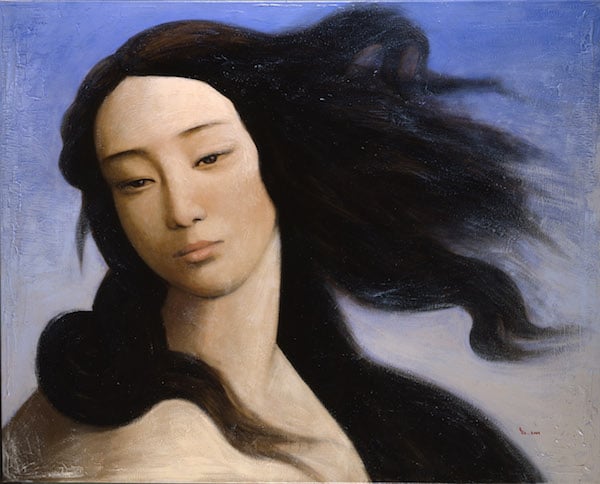Venus after Botticelli by Yin Xin
Sorry for another late blog, but alas, some weekends are not meant to be, especially coming down after the WIPS and crawling back up again. The WIPs went pretty well (as some of you from my course might know) and it seems to be just a case of cracking on which, of course, I have been struggling to do thanks to all the other exciting things that I can't let go of...Such is life. I'm telling myself that tomorrow will be the day, and I will work from home so that I don't get distracted.
In the meantime, I thought I would quickly whiz through my thoughts of the Botticelli Reimagined exhibition (lots of reimagining going on, don't you think?). In spite of my busy-ness, somehow I told myself I had time to do this on the opening day with Chris and Hannah. I'll be frank - I thought that they had overdone it and lots of bits felt like fillers, probably because it is in the biggest exhibition space at the V&A. As a 'modernist' though, I loved a lot of the first room holding the 'Reimagined' bit, and much of it was incredibly impressive, sometimes accidental, interpretations of Venus, and it had a lot of potential for interesting debates around gender, sexuality, the sexed gaze, beauty, etc. etc. and yet, I personally was disappointed with the texts on the walls and descriptions of the works. But for now, I'll talk about the pieces I liked.
There were two stand out pieces for me, which immediately made me think about how the beauty portrayed in Botticelli's The Birth of Venus has penetrated contemporary visual media; the first is an outstanding painting by Yin Xin, which of course caught my eye as one of the few Asian artists involved in a very Euro-centric (of course) exhibition. Obviously, Venus portrays a Caucasian ideal of beauty, but I found this one of the most captivating pieces in the whole exhibition and wished there was more content or context so that it could really push its agenda. From Yin Xin's series After, which is a series of paintings that visually changes figures from very famous European paintings to ethnic Chinese, clearly Yin is trying to problematise this historic conception of European female beauty, magnified and idealised in these idols portrayed by European men. I felt like more emphasis would have globalised 'Reimagining' much more clearly than what had been shown.
The other was a display of two photographs by Rineke Dijkstra from her series of Beach Portraits, which apparently was not intended to look like interpretations of Venus. There is a beautiful innocence to these pictures, especially the one I have included below. The poses of the two girls are strikingly close to the painted pose of Botticelli's Venus, and does make you question where these influences, if any come from. Clearly in Venus it is a male gaze (Botticelli) forming a female figure with a combination of sexuality and youth. But I feel the intention here is different, and I think it makes you think about Venus herself as an adolescent girl, on the cusp of...something - it is neither womanhood or adulthood or even girlhood. I feel like the two photographs really revealed something about our gaze as an audience of young girls, a very contentious subject which the Dijkstra didn't seem to intend. Yet in the context of the exhibition, it brings out these very complicated relationships between the historic and contemporary views of girls and of ourselves.
After that, I wasn't massively impressed until the end room with two studies of Venus, two beautiful luminous, full body portraits of her. What was fantastic was being able to compare the two studies, noticing a fuller body, a different hairstyle, the slight tilt of the arm or the leg, which you never get to see with such famous paintings. Its great to see a process, maybe a 'vulnerability' in a work in progress, from what seems like a man who is intent on a specific beauty.
Beach Portraits by Rineke Dijkstra

